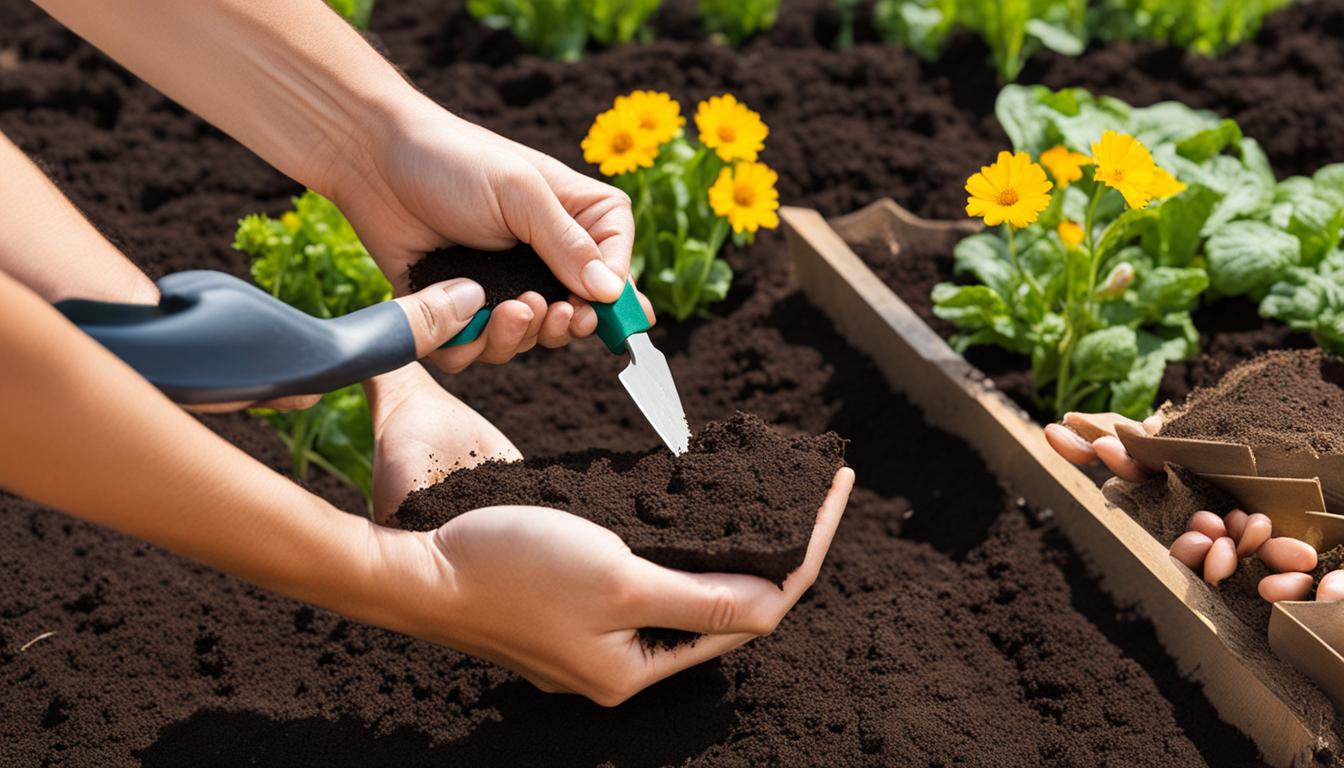Are you ready to embark on a new journey into the world of gardening? Whether you have a spacious backyard or a cozy balcony, starting a garden is a fulfilling and rewarding experience. Don’t worry if you don’t consider yourself to have a green thumb – with the right guidance and a dash of enthusiasm, anyone can create a vibrant and thriving garden. In this beginner’s gardening guide, I’ll walk you through the basics of starting and maintaining your very own garden.
Key Takeaways:
- Gardening is a delightful and enriching activity that offers multiple health benefits.
- Choosing the right location for your garden is essential, ensuring adequate sunlight and easy access to water.
- Preparing the soil with nutrient-rich options, such as Miracle-Gro® All Purpose Garden Soil, sets the foundation for success.
- Container gardening is an excellent option for those with limited space, allowing you to grow a variety of plants in pots.
- Knowing your hardiness zone and selecting plants accordingly is crucial for their survival and growth.
The Benefits of Gardening
Gardening is more than just a hobby; it offers a wide range of health benefits that can improve your overall well-being. Studies have shown that spending time in nature and engaging in gardening activities can lower blood pressure, improve mood, and even promote a healthier lifestyle. Let’s explore the incredible benefits that gardening has to offer:
1. Lower Blood Pressure
Gardening is a physical activity that promotes cardiovascular health and can help lower blood pressure. Spending time outdoors, digging, planting, and tending to your plants, not only gets your body moving but also stimulates the release of endorphins, which are natural mood boosters. So, by taking up gardening, you can enjoy the tranquility of nature while taking care of your heart.
2. Improve Mood and Mental Well-being
Gardening therapy, also known as horticulture therapy, has become increasingly popular for its positive impact on mental health. The calm and green environment of a garden can have a soothing effect on the mind, reducing stress and anxiety. The act of nurturing plants and witnessing their growth can give a sense of purpose and accomplishment, improving overall mood and mental well-being.
3. Exercise Creativity and Enhance Curb Appeal
Gardening allows individuals to express their creativity by designing and arranging plants, flowers, and various garden features. Whether you prefer vibrant flower beds or a vegetable garden, the possibilities are endless. Additionally, a well-maintained garden can enhance the curb appeal of your home, creating a welcoming and beautiful space for you and your loved ones to enjoy.
4. Lead a Healthier Lifestyle
Engaging in gardening requires physical activity and regular outdoor exposure. From digging and weeding to carrying pots and watering plants, these activities can contribute to a more active lifestyle. Gardening also encourages a healthier diet, as you can grow your own fresh fruits, vegetables, and herbs, ensuring that you have access to nutritious, homegrown produce.
By taking up gardening, you can enjoy the numerous health benefits it offers, including lower blood pressure, improved mood, and a more active lifestyle. So, grab your gardening tools, spend time in nature, and let your garden be an oasis of wellness in your life.
Choosing the Right Location for Your Garden
The location of your garden plays a vital role in its success. To ensure your plants thrive, it’s important to select a suitable garden location that meets their sunlight and water requirements.
1. Sunlight
Most plants require ample sunlight to grow and thrive. Choose a spot in your yard that receives at least 6 hours of direct sunlight daily. This will provide your plants with the energy they need for photosynthesis and growth.
2. Water Source
Proximity to a water source is crucial for the hydration of your plants. Make sure your garden is located within easy reach of a water supply. This will simplify the watering process and help maintain the optimal moisture levels for your plants.
3. Visibility
Consider placing your garden in a visible area of your yard. This will serve as a reminder to regularly care for and maintain your plants. Additionally, a visible garden can enhance the overall aesthetics of your outdoor space.
| Factors to Consider | Sunlight | Water Source | Visibility |
|---|---|---|---|
| Importance | High | High | Moderate |
| Sunlight Requirements | At least 6 hours of direct sunlight | N/A | N/A |
| Water Source Requirements | N/A | Easy access to a water supply | N/A |
| Benefits | Optimal plant growth and photosynthesis | Convenient watering process | Enhanced aesthetics and regular care |
Choosing the right location for your garden is the first step towards creating a thriving and beautiful outdoor space. By considering factors such as sunlight, water source proximity, and visibility, you can provide your plants with the optimal conditions for growth and ensure a successful gardening experience.
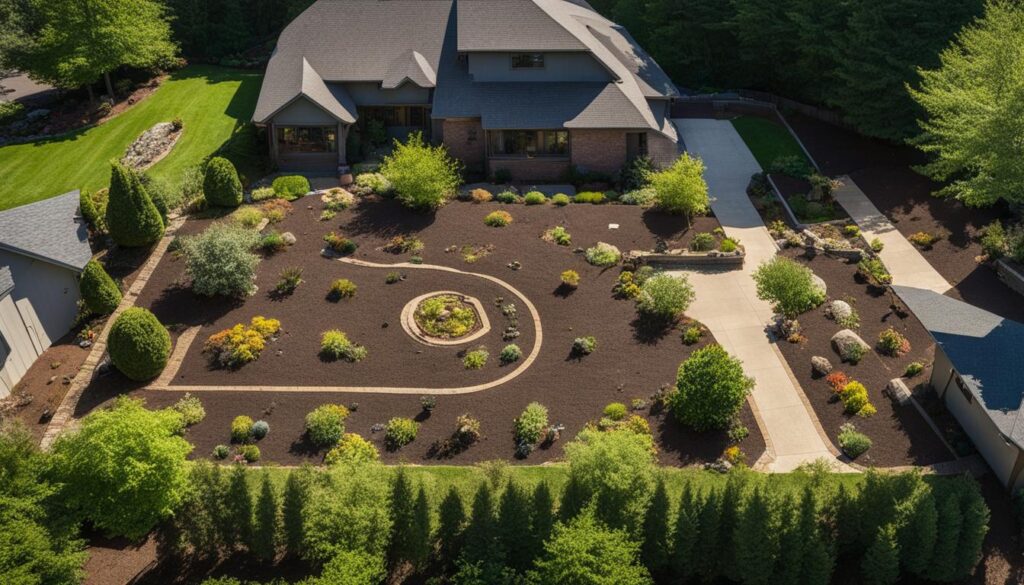
Preparing the Soil
Investing in nutrient-rich and well-drained soil is essential for starting a healthy garden. Proper soil preparation sets the foundation for successful gardening.
When preparing the soil for in-ground planting, incorporate 3 inches of Miracle-Gro® All Purpose Garden Soil into the top 6 to 8 inches of existing soil. This nutrient-rich soil will provide essential nutrients for your plants to thrive.
If you prefer raised bed gardening, the ideal choice is Miracle-Gro® Raised Bed Soil. This specially formulated soil promotes healthy root development and drainage, creating the perfect growing environment for your plants.
To prepare the soil, start by removing any weeds, rocks, or debris from the planting area. Loosen the soil using a garden fork or tiller to ensure proper airflow and water drainage. If the soil is compacted, consider adding organic matter such as compost or peat moss to improve its texture.
You can also conduct a soil test to determine its pH level and nutrient content. This will help you identify any deficiencies and determine the appropriate amendments needed to optimize the soil conditions for your plants.
Remember that different plants have different soil preferences, so it’s important to research the specific requirements of the plants you intend to grow. This will ensure that your garden thrives and produces bountiful yields.
“Good soil, like good friends, is essential for a thriving garden.”
Benefits of Proper Soil Preparation:
- Enhances root development and nutrient absorption
- Improves water drainage and prevents waterlogging
- Reduces the risk of soilborne diseases and pests
- Provides a stable anchoring system for plants
- Increases overall plant health and productivity
By taking the time to prepare your soil properly, you’ll create a nurturing environment where your plants can flourish. Get your gardening journey off to a great start by investing in quality soil and giving your plants the nutrients they need to thrive.
Container Gardening
If you have limited space, container gardening is a great option. You can grow a variety of plants, including vegetables, herbs, flowers, fruit trees, and shrubs, in pots. Container gardening is a versatile solution for small spaces, allowing you to enjoy the benefits of gardening even if you don’t have a large yard or garden area.
When choosing containers for your plants, it’s important to consider the size and needs of each plant. Some plants, like tomatoes or peppers, require larger pots to allow for root growth. On the other hand, herbs or flowers can thrive in smaller containers.
Filling your containers with the right potting mix is crucial for the success of your container plants. Miracle-Gro® Moisture Control® Potting Mix is a great option that provides optimal growth by retaining moisture while still allowing for proper drainage. This helps prevent overwatering and root rot, ensuring your plants stay healthy.
Container gardening offers the flexibility to move your plants around to find the best sunlight or protect them from adverse weather conditions. Whether you have a balcony, patio, or window ledge, you can create a beautiful container garden that adds a touch of nature to your small space.
To give you a better idea of container gardening possibilities, here’s a table showcasing popular plants and their suitable container sizes:
| Plant | Suitable Container Size |
|---|---|
| Tomatoes | 5-gallon or larger pots |
| Basil | 6-inch pots |
| Geraniums | 8-10-inch pots |
| Strawberries | Hanging baskets or 12-inch pots |
Remember to choose plants that complement each other in terms of sunlight and watering needs when designing your container garden. This will help you create visually appealing and balanced arrangements.
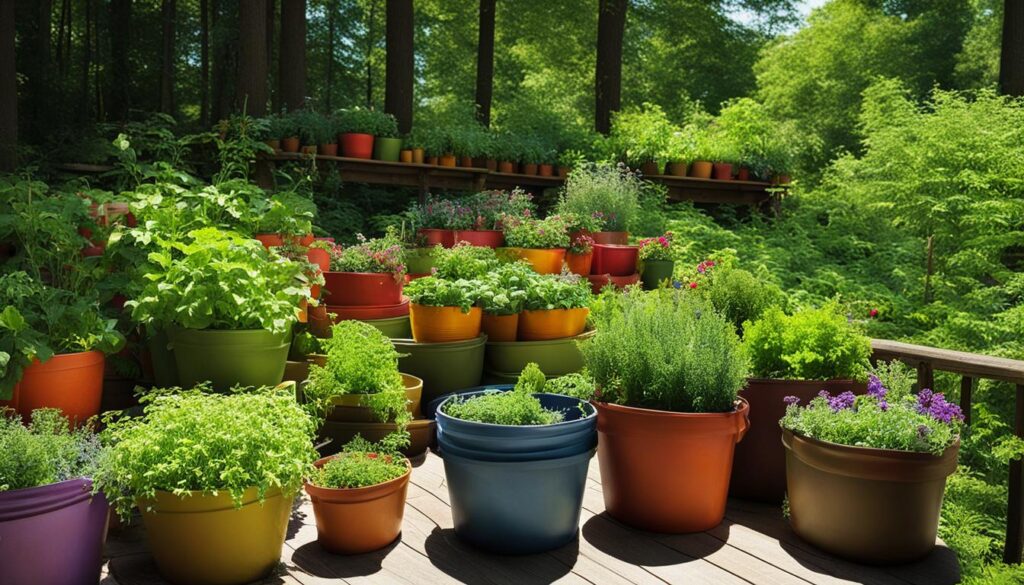
Container gardening is not only a practical solution for small-space gardening but also a creative outlet for expressing your personal style. Experiment with different combinations of plants, colors, and textures to create a charming oasis in your limited space.
Selecting the Right Plants
Choosing the right plants for your garden is essential for their success. You want to ensure that the plants you select thrive in your specific growing conditions. Consider factors such as sunlight, temperature, and available space when making your plant selections. By choosing the right plants, you can create a beautiful and healthy garden.
Here are some tips to help you select the right plants:
- Assess the amount of sunlight your garden receives throughout the day. Some plants require full sun, while others prefer partial shade. Choose plants that match the sunlight conditions in your garden.
- Take into account the average temperature in your area. Some plants are more heat-tolerant and will thrive in warm climates, while others prefer cooler temperatures. Select plants that are suited to the temperature range in your region.
- Consider the available space in your garden. Some plants, such as vines, require ample room to grow and spread. Make sure you have enough space to accommodate the plants you choose.
If you’re a beginner gardener, starting with young plants from Bonnie Plants® can give you a head start on successful gardening. Young plants are already established and have a higher chance of thriving in your garden. You can find a wide variety of heat-tolerant plants from Bonnie Plants® that are suitable for different growing conditions.
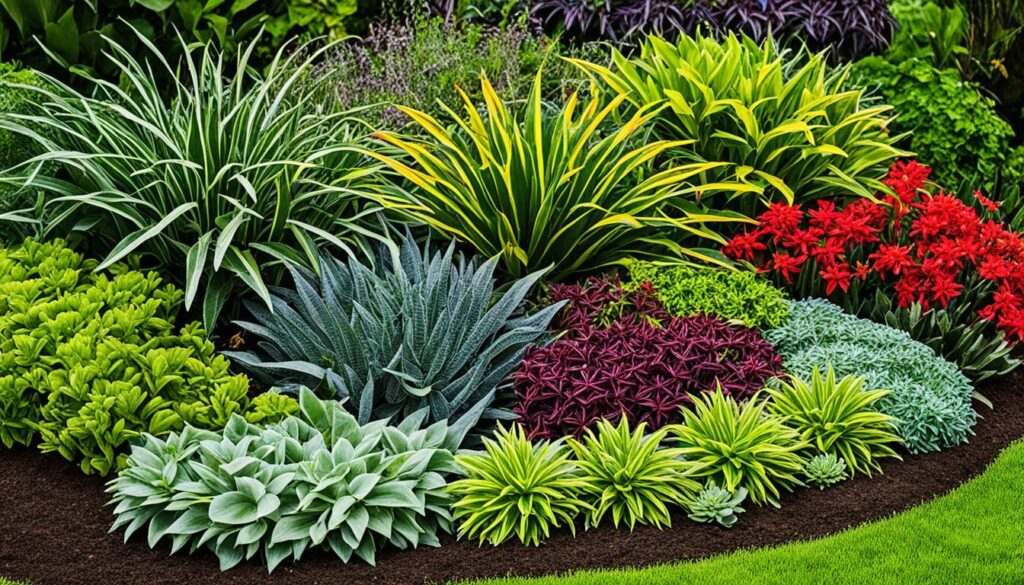
Testimonial:
“I love how easy it is to find the perfect plants for my garden with Bonnie Plants®. The young plants are always healthy and ready to thrive in my growing conditions.” – Laura, avid gardener
Understanding Hardiness Zones
Familiarize yourself with your hardiness zone to ensure you select plants that can tolerate the climate conditions in your area. The higher the zone number, the warmer the climate. Being aware of your hardiness zone can help you make informed decisions when choosing plants for your garden.
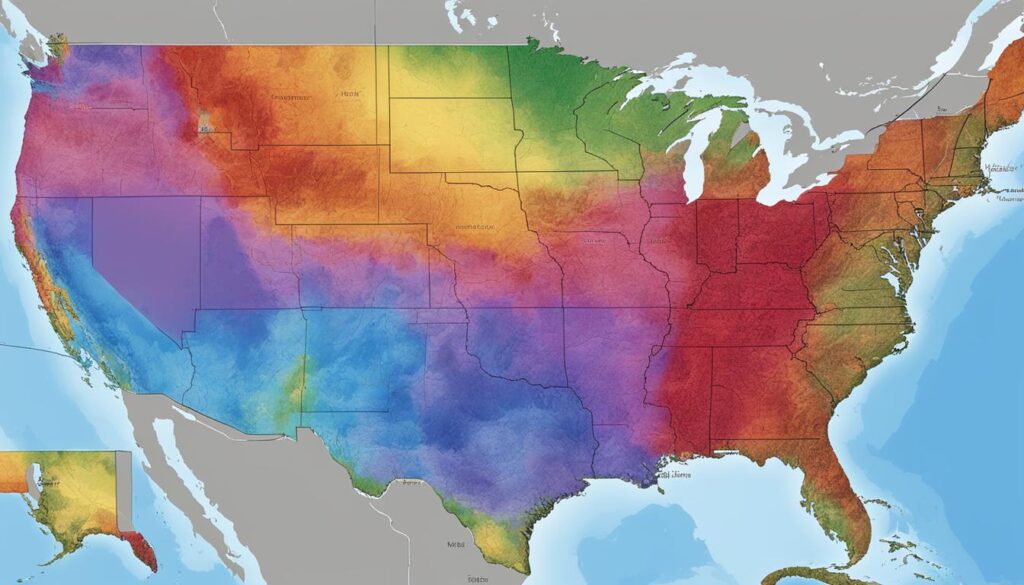
Hardiness zones categorize regions based on their average annual minimum temperature. By understanding your hardiness zone, you can determine which plants are most likely to thrive in your specific climate. This knowledge will maximize your gardening success and ensure that your plants are able to withstand the temperature and weather conditions of your area.
Plant hardiness is crucial because different plants have different temperature requirements. Some plants, like tropical flowers, need a warm climate to grow, while others, like certain herbs and wildflowers, can thrive in cooler temperatures. By selecting plants that are suited to your hardiness zone, you increase the likelihood of a successful and vibrant garden.
To determine your hardiness zone, you can refer to the USDA Plant Hardiness Zone Map. This map divides North America into distinct zones based on their average minimum winter temperature. Each zone is labeled with a corresponding number. For example, Zone 1 indicates the coldest climate conditions, while Zone 13 represents the warmest.
“Understanding your hardiness zone is like having a roadmap for gardening success. It helps you navigate the complex world of plants and ensures that you choose the right ones for your specific climate conditions.” – Gardening enthusiast
Planting Success by Hardiness Zone
In order to make the most of your garden, it’s important to select plants that are well-suited to your hardiness zone. Take a look at the table below for a quick guide on the plant selection for each zone:
| Hardiness Zone | Climate Characteristics | Recommended Plants |
|---|---|---|
| Zone 1 | Coldest climate | Evergreens, winter vegetables, cold-hardy perennials |
| Zone 4 | Short growing season with cold winters | Lettuce, onions, peas, cold-tolerant flowers |
| Zone 7 | Mild winters with hot summers | Tomatoes, peppers, strawberries, heat-loving perennials |
| Zone 10 | Hot and humid climate | Tropical fruits, orchids, bromeliads, cacti |
Keep in mind that these recommendations are general guidelines, and it’s always best to consult local gardening resources or seek advice from experienced gardeners in your area for more specific plant suggestions.
Understanding your hardiness zone is just one piece of the gardening puzzle. In the next section, we’ll explore essential gardening tips that will further enhance your gardening journey and ensure a bountiful harvest.
Essential Gardening Tips
When it comes to gardening, there are a few essential tips that can make a big difference in the success of your plants. Paying attention to frost dates, using mulch, regularly feeding your plants, and having the right garden tools are all key to maintaining a healthy and vibrant garden.
1. Frost Dates
Frost dates can vary depending on your location, and it’s important to know the average last spring frost date and first fall frost date in your area. By being aware of these dates, you can avoid planting tender plants too early in the season or risk damaging them with late frosts. Plan your planting schedule accordingly to give your plants the best chance to thrive.
2. Mulching
Mulching is a crucial practice in gardening that offers multiple benefits. Applying a layer of mulch around your plants helps suppress weeds, which compete with your plants for nutrients and water. It also helps conserve moisture in the soil, reducing the need for frequent watering, and maintains a more stable soil temperature. Use organic mulch, such as shredded bark or straw, and apply it in a 2-3 inch layer around your plants.
3. Regular Plant Feeding
Just like humans, plants need regular nourishment to stay healthy and grow vigorously. Feeding your garden with a high-quality plant food, such as Miracle-Gro® Water Soluble All Purpose Plant Food, provides essential nutrients that may be lacking in your soil. Follow the instructions on the packaging to ensure proper application and give your plants the nutrition they need to thrive.
4. Basic Garden Tools
Having the right garden tools can make your gardening experience much easier and enjoyable. Here are a few basic tools every gardener should have:
- Garden gloves for hand protection
- Trowel for digging and planting
- Pruning shears for trimming and shaping plants
- Garden rake for leveling soil and removing debris
- Watering can or garden hose for irrigation
Investing in these basic tools will help you tackle a variety of gardening tasks, from planting to maintenance and harvesting.
“Good tools make good work.” – Leonard Adelman
Remember, gardening is a rewarding and therapeutic activity that can bring joy and beauty to your life. By incorporating these essential gardening tips into your routine, you’ll be well on your way to creating a flourishing garden that you can enjoy for years to come.
Conclusion
Starting your own garden is a rewarding experience, even if you don’t consider yourself to have a green thumb. By following the tips and advice in this gardening guide for beginners, you can create a thriving garden and enjoy the many benefits of gardening.
First, choose the right location for your garden. Ensure it receives at least 6 hours of sunlight daily and is easily accessible to a water source. A visible area will remind you to regularly care for your plants.
Next, prepare the soil by investing in nutrient-rich and well-drained soil. Incorporating Miracle-Gro® All Purpose Garden Soil or Miracle-Gro® Raised Bed Soil will set the foundation for success.
Selecting the right plants for your growing conditions is vital for their success. Choose heat-tolerant varieties for warmer climates and provide adequate space for vines to grow. Starting with young plants from Bonnie Plants® can give you a head start on a thriving garden.
Lastly, remember to provide regular care and maintenance for your garden. Be aware of your hardiness zone, protect your plants from frost, mulch to reduce weeds, and regularly feed your garden with Miracle-Gro® Water Soluble All Purpose Plant Food. With these essential gardening tips, you’ll be well on your way to a beautiful and flourishing garden, regardless of your green thumb status. Happy gardening!
FAQ
What are the health benefits of gardening?
Gardening has been shown to have numerous health benefits, including reducing blood pressure and improving mood. Spending time in a calm, green environment can have a positive impact on mental health. Gardening also allows individuals to exercise their creativity and lead a healthier lifestyle.
How do I choose the right location for my garden?
Choose a spot in your yard that receives at least 6 hours of sunlight daily and has easy access to a water source. Consider placing your garden in a visible area to encourage regular care and maintenance.
How do I prepare the soil for my garden?
Investing in nutrient-rich and well-drained soil is essential. Incorporate Miracle-Gro® All Purpose Garden Soil into the top 6 to 8 inches of existing soil for in-ground planting. For raised beds, Miracle-Gro® Raised Bed Soil is recommended.
Can I start a garden in containers?
Yes, container gardening is a great option for those with limited space. You can grow a variety of plants in pots, including vegetables, herbs, and flowers. Use Miracle-Gro® Moisture Control® Potting Mix for optimal growth.
How do I select the right plants for my garden?
Consider the amount of sunlight, temperature, and available space when selecting plant varieties. Opt for heat-tolerant plants in warm climates and provide ample room for vines to grow. Starting with young plants from Bonnie Plants® can give you a head start on successful gardening.
What are hardiness zones and why are they important?
Hardiness zones help determine which plants can tolerate the climate conditions in your area. The higher the zone number, the warmer the climate. Being aware of your hardiness zone can help you select plants that are suitable for your garden.
How can I protect my plants from frost?
Pay attention to the average last spring frost date and first fall frost date in your area to avoid damaging your plants. Applying a layer of mulch around each plant can help reduce weeds and conserve moisture. Regularly feeding your garden with plant food, such as Miracle-Gro® Water Soluble All Purpose Plant Food, can also promote healthy growth.
What are some essential gardening tips?
Some essential gardening tips include knowing your frost dates, mulching your plants, regularly feeding them with plant food, and having the basic garden tools on hand for easier maintenance and care.
Can I start a garden even if I don’t have a green thumb?
Absolutely! Starting your own garden is a rewarding experience, even for beginners. By following the tips and advice in this ultimate gardening guide for beginners, you can create a thriving garden and enjoy the many benefits of gardening.

